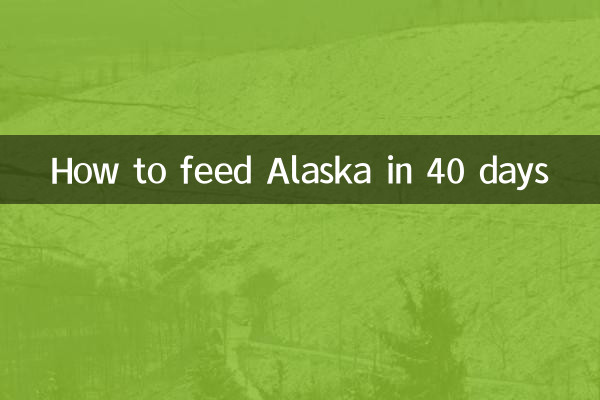How to feed Alaska in 40 days
The Alaskan Malamute is a large, strong dog breed that is loved by pet lovers for its friendly personality and loyal qualities. If you have just adopted a 40-day-old Alaskan puppy, then how to feed and care for it scientifically becomes your primary concern. Below is a detailed guide to feeding, caring for and training your 40-day-old Alaskan puppy.
1. Feeding Guide for 40-Day Alaskan Puppies

The 40-day-old Alaskan puppies are in a period of rapid growth and need adequate nutrition to support the development of their bones and muscles. Here are daily dietary recommendations for puppies:
| food type | Feeding frequency | Things to note |
|---|---|---|
| Dog food for puppies | 4-5 times a day | Choose high-quality dog food that is high in protein and low in fat |
| goat milk powder | 2-3 times a day | Avoid milk as it may cause diarrhea |
| cooked chicken/beef | 2-3 times a week | Chop it into pieces and mix into dog food, avoid adding seasonings |
| Vegetable puree (carrots, pumpkin) | 1-2 times a week | Supplement vitamins and fiber |
2. Care points for 40-day-old Alaskan puppies
Puppy care includes aspects such as hygiene, sleep and health monitoring. Here are the key considerations:
| nursing project | Frequency | Specific operations |
|---|---|---|
| take a bath | 1-2 times a month | Use puppy-specific shower gel and water at a moderate temperature |
| deworming | 1 time per month | Internal drive and external drive need to be carried out simultaneously |
| Vaccination | As recommended by your veterinarian | Completed core vaccines for canine distemper, parvovirus, etc. |
| grooming | 2-3 times a week | Use a pin comb to remove loose hair |
3. Training suggestions for 40-day-old Alaskan puppies
Early socialization training is crucial to the development of the Alaskan dog’s character. The following is basic training content suitable for puppies:
| training items | Best start time | training method |
|---|---|---|
| Fixed-point defecation | From 40 days | Lay out changing pads at fixed locations and provide timely rewards |
| name response | From 45 days | Use snacks to strengthen name memory |
| Basic commands (sit, wait) | From 2 months | 5 minutes of short training every day |
| social training | After the vaccine is completed | Exposure to friendly people and other dogs |
4. Frequently Asked Questions
Q: Can I take a 40-day trip to Alaska?
A: It is not recommended to take it out immediately. Puppies have weak immune systems and need to complete all vaccinations before gradually being exposed to the outside environment.
Q: What should I do if my puppy keeps barking at night?
A: It may be separation anxiety or environmental discomfort. You can place items with mother's scent next to the nest, use a hot water bottle to simulate body temperature, and keep the environment quiet at night.
Q: How to determine whether a puppy is healthy?
A: A healthy puppy should have: a moist nose, bright eyes, a lively mental state, and well-formed stools. If you have persistent diarrhea, vomiting or loss of appetite, seek medical attention immediately.
5. Feeding precautions
1.Temperature control:Alaskan puppies are afraid of heat. It is recommended that the ambient temperature be kept at 18-22°C. Special attention should be paid to preventing heatstroke in summer.
2.Sports Management:Avoid strenuous exercise and do gentle activities for 10-15 minutes 3-4 times a day.
3.Hazard precautions:Keep away electrical wires and small objects at home to prevent puppies from accidentally eating them.
4.Regular physical examination:It is recommended to conduct a comprehensive physical examination every 2 months to monitor growth and development.
With scientific feeding and careful care, your Alaskan puppy will grow up healthily into a majestic yet gentle companion dog. Remember, the investment you make at this stage will lay a solid foundation for a lifetime of health.

check the details

check the details